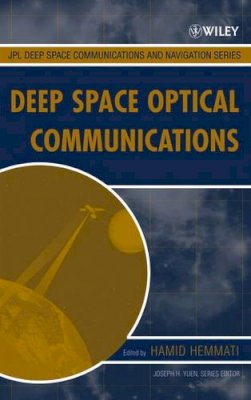
Stock image for illustration purposes only - book cover, edition or condition may vary.
Deep Space Optical Communications
Hemmati
€ 333.28
FREE Delivery in Ireland
Description for Deep Space Optical Communications
Hardcover. This is the first book that specifically addresses Optical Communications from planetary distances. There are specific technologies and requirements that are unique to deep-space links and differ from either Earth-orbit to Earth, or terrestrial, optical communication links. Editor(s): Hemmati, Hamid. Series: JPL Deep-Space Communications and Navigation Series. Num Pages: 736 pages, Illustrations. BIC Classification: TJ. Category: (P) Professional & Vocational. Dimension: 235 x 161 x 38. Weight in Grams: 1144.
A quarter century of research into deep space and near Earth optical communications
This book captures a quarter century of research and development in deep space optical communications from the Jet Propulsion Laboratory (JPL). Additionally, it presents findings from other optical communications research groups from around the world for a full perspective. Readers are brought up to date with the latest developments in optical communications technology, as well as the state of the art in component and subsystem technologies, fundamental limitations, and approaches to develop and fully exploit new technologies.
The book explores the unique requirements and technologies for deep space optical communications, including:
* Technology overview; link and system design drivers
* Atmospheric transmission, propagation, and reception issues
* Flight and ground terminal architecture and subsystems
* Future prospects and applications, including navigational tracking and light science
This is the first book to specifically address deep space optical communications. With an increasing demand for data from planetary spacecraft and other sources, it is essential reading for all optical communications, telecommunications, and system engineers, as well as technical managers in the aerospace industry. It is also recommended for graduate students interested in deep space communications.
This book captures a quarter century of research and development in deep space optical communications from the Jet Propulsion Laboratory (JPL). Additionally, it presents findings from other optical communications research groups from around the world for a full perspective. Readers are brought up to date with the latest developments in optical communications technology, as well as the state of the art in component and subsystem technologies, fundamental limitations, and approaches to develop and fully exploit new technologies.
The book explores the unique requirements and technologies for deep space optical communications, including:
* Technology overview; link and system design drivers
* Atmospheric transmission, propagation, and reception issues
* Flight and ground terminal architecture and subsystems
* Future prospects and applications, including navigational tracking and light science
This is the first book to specifically address deep space optical communications. With an increasing demand for data from planetary spacecraft and other sources, it is essential reading for all optical communications, telecommunications, and system engineers, as well as technical managers in the aerospace industry. It is also recommended for graduate students interested in deep space communications.
Product Details
Format
Hardback
Publication date
2006
Publisher
John Wiley & Sons Inc United Kingdom
Number of pages
736
Condition
New
Series
JPL Deep-Space Communications and Navigation Series
Number of Pages
736
Place of Publication
, United States
ISBN
9780470040027
SKU
V9780470040027
Shipping Time
Usually ships in 7 to 11 working days
Ref
99-50
About Hemmati
HAMID HEMMATI, PhD, is a principal member of the technical staff and the Technical Group Supervisor of the JPL Optical Communications Group, which is developing optical communication technologies to and from spacecraft in Earth orbit and deep space. Dr. Hemmati has published more than 100 journal and conference papers, holds seven patents, and has received thirty NASA Certificates of Recognition.
Reviews for Deep Space Optical Communications
